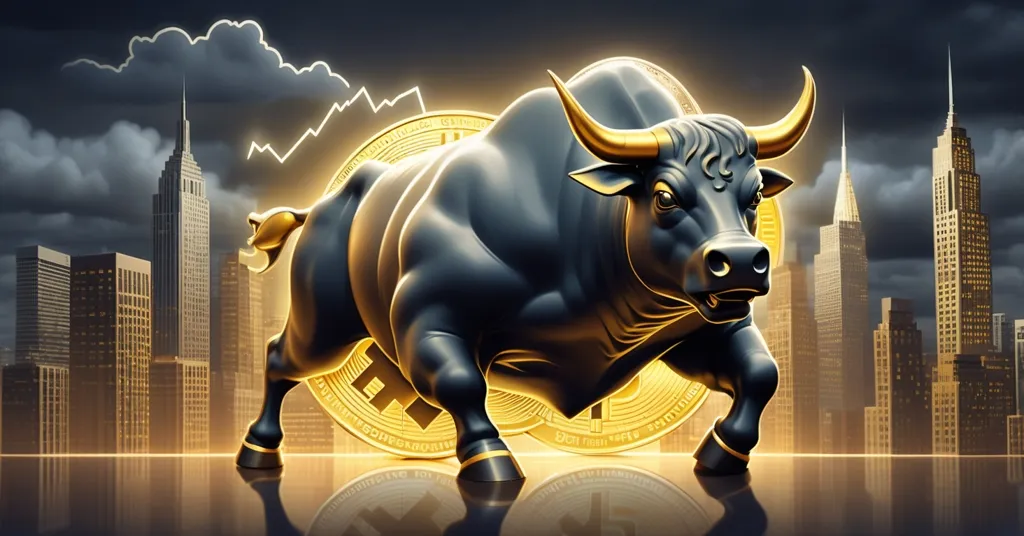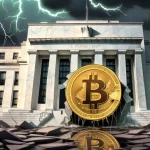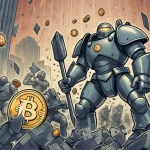Powell’s Rate Cut Hint and Nvidia Earnings Ignite Bitcoin Market Buzz

Wall Street’s August Rally: Powell’s Rate Cut Hint and Nvidia’s Earnings Spark Bitcoin Buzz
Wall Street capped off a historically slow August with a roaring comeback, fueled by Federal Reserve Chairman Jerome Powell’s dovish stance on interest rates during his Jackson Hole speech. With major indices smashing records and tech giants flexing muscle, attention now shifts to Nvidia’s earnings report and looming inflation data—events that could ripple into the Bitcoin and crypto markets with serious implications for risk assets.
- Powell’s Game-Changer: Fed signals a likely mid-September rate cut, igniting a market surge.
- Record-Breaking Gains: Dow leaps over 900 points, with S&P 500 and Russell 2000 riding high.
- Nvidia in Focus: Earnings loom with high expectations, despite China-related geopolitical risks.
- Crypto Connection: Rate cuts could boost Bitcoin, but economic cracks remain a threat.
Powell’s Rate Cut Bombshell: A Shot in the Arm for Markets
On August 22, 2025, at the Jackson Hole Economic Symposium in Wyoming, Jerome Powell delivered a speech that could go down as a turning point for financial markets. His words hinted strongly at a mid-September interest rate cut—a dovish pivot (meaning a policy favoring lower rates to juice economic growth, much like a caffeine boost for a sluggish system)—and unleashed a wave of optimism. After months of tight monetary policy to curb post-pandemic inflation, Powell’s focus seemed to shift toward supporting a cooling labor market, with payroll growth slowing to a mere 35,000 per month from 168,000 earlier in 2024, and unemployment creeping up to 4.2%. The market response was immediate and electric: the Dow Jones Industrial Average skyrocketed over 900 points in a single session (a roughly 2% gain), hitting an all-time high. The S&P 500 Equal Weight Index broke its November 2023 peak, while the Russell 2000, a gauge of small-cap stocks, surged over 3%.
Tech sectors, often a bellwether for risk appetite, led the charge. Semiconductors, regional banks, and large-cap tech stocks rallied hard, with the “Magnificent Seven”—a clique of tech titans like Apple and Microsoft—piling on nearly $370 billion in market value in one day. That’s more than the entire worth of a household name like Procter & Gamble. Sam Stovall, Chief Investment Strategist at CFRA Research, captured the mood perfectly:
“Powell delivered a final Jackson Hole speech to be remembered. He essentially gave investors what they had been hoping for, which was a dovish outlook on future Fed policy.”
Stovall didn’t stop there, pointing out the psychological lift this provided:
“It has removed an important restraint that was tied to investor optimism. In that the Fed now seems fairly clear that they will, or are leaning toward, cutting rates in mid-September.”
August’s overall performance reflects this newfound confidence. The Dow has climbed over 3% for the month, the S&P 500 is up 2%, and even the tech-heavy Nasdaq Composite, despite earlier stumbles, managed a 1% gain. But let’s not pop the champagne just yet. Powell also flagged upside risks to inflation, partly due to new tariffs hiking goods prices by 1.1% over the past year. With GDP growth projected to slow to 1.2% in the first half of 2025 (down from 2.5% in 2024), Wall Street’s betting hard on the Fed going soft, but the foundation feels shakier than a house of cards in a windstorm. For a deeper dive into market reactions, check out this analysis of Wall Street’s strong August finish.
Inflation Data on Deck: Will the PCE Index Derail the Party?
Next up is the release of July’s Personal Consumption Expenditures (PCE) price index, the Fed’s preferred inflation yardstick. For the uninitiated, the PCE tracks price changes in goods and services people actually buy, adjusting for shifts in behavior—think of it as a broader, more flexible cousin to the Consumer Price Index (CPI). Forecasts peg a year-over-year rise of 2.9%, up a hair from June’s 2.8%. While tariffs might nudge costs higher, most analysts reckon this slight bump won’t torpedo the case for a rate cut, as detailed in this expert breakdown of July PCE data and rate cut expectations. Stovall remains unshaken:
“Investors are well aware of short-term hurdles. So, next week, I think, should end up being a positive week.”
Still, Powell himself sounded a note of caution in his speech, warning that a one-time price spike could morph into a persistent inflation problem if wage-price spirals or shifting expectations take hold. Translation: the Fed’s got its finger on the trigger for a cut, but they’re not blind to the risk of backtracking if inflation rears its ugly head. For markets, and especially for risk assets like Bitcoin, this tightrope act between easing policy and stubborn price pressures is a critical watchpoint.
Nvidia Earnings: Tech Titan or Ticking Time Bomb?
While Powell’s words lit a fire under equities, the next big test comes with Nvidia’s earnings report on August 27, 2025. This semiconductor giant, a linchpin of the AI and tech boom, is expected to crush forecasts, driven by innovations like the Blackwell Ultra GB300 GPU, which boasts 50x faster AI inference—basically, a turbo engine for machine learning. Hyperscalers like Amazon and Microsoft are pouring billions into AI infrastructure ($118B and $88B projected for 2025, respectively), and Nvidia stands to cash in, as explored in this forecast on Nvidia’s Q3 earnings potential. Harsh Kumar, Semiconductor Analyst at Piper Sandler, is betting big:
“We anticipate a meaningful uptick in estimates on the Street for Nvidia, when these earnings are done.”
But here’s where it gets dicey. Nvidia’s forward P/E ratio sits at a lofty 34.78X, with analyst price targets of $210–$215 suggesting a 13–21% upside from its current $173.37. At that valuation, is Nvidia a tech titan or just another over-hyped bubble waiting to burst? More troubling are the geopolitical storm clouds. With 13.11% of its revenue tied to China (down from 21.45% in 2023), Nvidia is caught in the crosshairs of U.S.-China tech tensions, a concern highlighted in this report on Nvidia’s geopolitical risks with China. U.S. export controls, dating back to the Trump administration, bar Nvidia from selling top-tier chips to Beijing, shrinking its market share. Meanwhile, China’s “Delete America” initiative aims for 55% domestic AI chip production by 2027, reducing reliance on firms like Nvidia. CEO Jensen Huang has been playing hardball, negotiating with the U.S. government for modified chip exports, including a deal funneling 15% of China sales revenue back to Uncle Sam as part of a licensing agreement. Add in manufacturing risks with TSMC in Taiwan—a geopolitical hotspot—and you’ve got a recipe for volatility.
For the crypto space, Nvidia’s fate isn’t just a tech story. Their GPUs power mining rigs and decentralized AI projects on platforms like Ethereum. If geopolitical risks disrupt supply chains or crater Nvidia’s stock, it could hit hardware availability for blockchain infrastructure, stunting growth in niches Bitcoin doesn’t fill. Sure, strong earnings might fuel a broader tech rally, lifting crypto sentiment, but don’t ignore the tripwires. As Henry Rivers from AI Invest warns with a “Hold” rating, near-term margin pressures and political risks could spoil the party.
Crypto’s Tightrope: Will Rate Cuts Fuel Bitcoin or Flop?
Now, let’s zero in on what this means for Bitcoin and the broader crypto ecosystem—our bread and butter. A Fed rate cut is often a green light for risk assets. Lower interest rates slash borrowing costs and reduce the opportunity cost of holding non-yielding assets like Bitcoin, effectively opening a faucet of cheap money that tends to flow into speculative corners like crypto. Historically, Bitcoin has seen gains of 20-30% in the three months following Fed rate cut announcements—think back to 2019 when easing policy sparked a mini bull run, a dynamic explored further in this analysis of rate cut effects on Bitcoin. With fiat fears simmering amid tariff-driven inflation and labor market wobbles, Bitcoin could shine as the ultimate middle finger to centralized control, a store of value that doesn’t wait for Fed approval.
But let’s play devil’s advocate with some no-bullshit clarity. Sure, cheap money sounds like a Bitcoin bonanza, but if unemployment spikes to 5% or consumer spending tanks, don’t expect a sustained moonshot—fear trumps greed every damn time. Economic fragilities, like GDP slowdowns to 1.2% next year, could trigger sell-offs across equities and digital assets alike if confidence falters. Altcoins and DeFi projects on Ethereum or Solana might tag along for any liquidity-driven ride, filling niches Bitcoin doesn’t touch, but they’re even more vulnerable to macro shocks. And don’t get me started on the shysters peddling “guaranteed” crypto gains off Fed hype—stick to fundamentals, not fairy tales. Community discussions, like those found in this Reddit thread on rate cuts and crypto, reflect similar mixed sentiments.
Then there’s the Nvidia angle for blockchain tech. Their advancements in AI hardware, like the Blackwell Ultra, could supercharge decentralized AI protocols—think Ethereum-based projects crunching machine learning for Web3 apps. But if U.S.-China tensions choke GPU supply chains, miners and developers could face delays or price gouges, hampering adoption, a connection unpacked in this Quora discussion on Nvidia earnings and crypto markets. For Bitcoin maximalists, this is a reminder that while BTC is king as a decentralized store of value, the ecosystem’s edges rely on tech innovation we can’t always control. Rate cuts might juice sentiment, but the cracks in the economic foundation could just as easily screw us over.
Key Takeaways for Bitcoin and Blockchain Investors
- What did Powell’s Jackson Hole speech signal for financial markets?
It strongly hinted at a mid-September rate cut, sparking a massive rally with the Dow surging over 900 points and lifting confidence across tech and equity sectors. - How could a Fed rate cut impact Bitcoin and cryptocurrencies?
Lower rates typically fuel risk-on behavior, potentially driving capital into Bitcoin as a store of value, though economic weaknesses like unemployment spikes could cap any rally. - Will upcoming inflation data derail the Fed’s rate cut plans?
July’s PCE index, expected to rise 2.9% year-over-year, is unlikely to halt a cut, but tariff-driven price pressures add uncertainty to long-term inflation control. - Why should crypto investors care about Nvidia’s earnings?
Strong results could boost tech sector sentiment, indirectly lifting crypto markets, while geopolitical risks with China might disrupt blockchain hardware supply chains critical for mining and DeFi. - What risks could sabotage a Bitcoin rally post-rate cut?
Slowing GDP growth, rising unemployment, and consumer spending drops could spark broader market fear, dragging down risk assets like Bitcoin despite liquidity boosts. - How does this fit into the bigger picture of decentralization?
While Wall Street cheers Fed moves, Bitcoin stands as a counterweight to centralized policy, reminding us that true financial freedom doesn’t hinge on government whims—though it’s not immune to macro storms.
What’s Next for Crypto Amid Wall Street’s Hype?
As August winds down, Wall Street’s cautiously jubilant mood—fueled by Powell’s rate cut tease and tempered by Nvidia’s high-stakes earnings—sets a fascinating stage for Bitcoin and blockchain enthusiasts. We might see renewed retail interest in crypto as a hedge if fiat devaluation fears grow, especially with tariffs and labor data in the mix. For those wanting to dig into Powell’s full remarks, his Jackson Hole speech transcript offers the unfiltered source. But markets hate surprises, and we’re not out of the woods yet. For every liquidity-driven upswing, there’s a potential gut punch waiting if economic indicators sour. Stick with us at Let’s Talk, Bitcoin as we track these crosswinds—because whether you’re a BTC maxi or an altcoin explorer, staying grounded amidst the hype isn’t just smart, it’s survival. We’re here to cut through the noise with raw, unfiltered insight.



